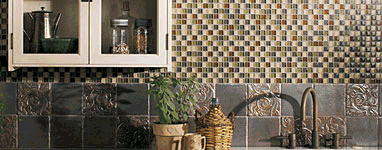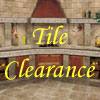|
 |

STONE TIPS
Over the last three decades, stone use has experienced an enormous growth both in commercial and in residential construction. But many misconceptions about this beautiful natural product do remain, especially in the area of maintenance.
Below are some tips and a few basic guidelines to follow in order to fully enjoy what mother nature has given us, and what man has - to some degree - transformed.
MARBLE Vs GRANITE
BLACK GRANITE FADING
BLACK SPOTS ON BLACK GRANITE
COUNTER TOPS: MARBLE OR GRANITE?
EFFLORESCENCE
FLOORING
GRANITE FLOOR BLANCHING
MARBLE POLISHING PROBLEMS
REMOVING RUST FROM STONE SURFACES
REMOVING STAINS FROM STONE, TILE & CONCRETE
WARPING OF GREEN MARBLE
WHY DOES STONE SHINE?
HOW TO HIRE A PROFESSIONAL STONE CONTRACTOR
The do's and don'ts about hiring the right person for the job.
|
MARBLE Vs GRANITE
From an aesthetic standpoint, it is all a matter of taste as to which one to use. Both types of stone have their own individual beauty and "personality".
MARBLE
Marble comes in an extremely wide range of colors, and offers wonderful veining. No two pieces of marble are ever alike. In fact, part of this natural stone's beauty is that its irregularities will make any floor, wall or other surface, unique and "alive". Granite also comes in a very large variety of colors. Its look, however, is more of a speckled and crystalline one. Veining may also occur in some granites, but still it is prevalently more uniform than marble. Marble is often favored for added sophistication to a particular setting. In residential environments, for example, it is widely used in entrance ways, living rooms (especially around a fireplace), bathrooms walls & floors, bathroom vanity tops & shower walls, as well as surrounding bathtubs. Marble is also very popular with furniture (modern and antique furnishings), and has countless applications with simple ornaments, such as vases, bookends, candle holders and many more.
No doubt about it: marble is indeed a beautiful stone. But as beautiful as it is, it may not always be a very pragmatic one, so serious consideration must be given to each individual application. When compared to granite, marble is a softer stone, and less stain & scratch resistant. Spills on marble surfaces must be removed at once to prevent possible damage to the stone, especially those containing oil or acid. One should also resist the temptation to clean marble with any type of abrasive products, in order to prevent scratches and loss of shine. A general rule is to understand & accept that, anything that can stain will generally stain marble, unless appropriate precautions are taken; this can be as simple as always using coasters on table tops, for example.
GRANITE
Granite can be just as beautiful as marble. It also has the advantage of offering additional value: it is stronger, does not scratch as easily, it is generally also more resistant in harsh environments, making it a prime candidate for many commercial projects. Further, those qualities make granite a great stone for many applications in a kitchen, and counter tops are a favorite. It is also widely used as dining room tables, bar tops and flooring, to name only a few. Granite is very durable. It is stain and scratch resistant, hence will require less care. Granite is also more suited for exterior applications than marble is. Because it is stronger, it also benefits from more surface treatment options. Granite is therefore a more versatile stone. One granite alone can offer several looks, each based on a different texture, and each of which equally as attractive. This gives the architect, the designer and the building owner, a much appreciated freedom of creativity.
So, marble or granite? Both equally beautiful; both with their individual characteristics to consider. The choice is yours, but one thing is for sure: Mother Nature did all right.....and we can't beat that!

|
BLACK GRANITE FADING
We have received numerous calls concerning the fading of black granite counter tops.&nbps; Why does black granite fade ?
The answer is, black granite should not fade. Black granite imported from Asia is sometimes doctored with dyes and oils to darken the surface. The fading is nothing more than the dyes and oils being removed. Unfortunately, the only fix is to re-polish the top. This can be costly.
Before purchasing a granite top perform the following test to find out if it has been doctored. Take a clean white rag and apply a some acetone to the surface of the granite. If any residue or black color is observed on the top, do not accept it, it has been dyed.

|
| BLACK SPOTS ON BLACK GRANITE
We received several calls from fabricators & restoration companies that are having problems with dark black spots appearing on black absolute and other black granites. This is a common problem caused by natural oils in the stone. The best way to eliminate these spots is to clean the stone with a mild acid wash. Try using a solution of oxalic or sulfamic acid. Make sure to test on a small spot first. Do not be alarmed if the spots come back. Several treatments may be necessary.

|
COUNTER TOPS: MARBLE OR GRANITE?
Both marble and granite can be used for kitchen counters, but each has its advantages and disadvantages. Marble is available in an unlimited number of colors, but scratches very easily. If you are going to be cutting meats and vegetables on these counters, marble is a poor choice.
Granite is very scratch resistant and will take cutting, but it can be porous. If you are doing a lot of cooking with hot oil, granite can easily stain. It can, however, be protected against staining if sealed with a good quality stone sealer. Most kitchen stone kitchen countertops are made of granite, which is overall a better choice than marble.

|
EFFLORESCENCE
An architect recently experienced efflorescence with Portugese sandstone installed on a fire place. Soon after the fixing mortar dried, staining and salts appeared on the lower sections of the surround. How can this be corrected?
If the sandstone is not polished, a light solution of vinegar and water can be used to remove the salts. After the salts are removed, the stone should be sealed with a good penetrating sealer. If the stains are imbedded in the stone, those stains can be removed using poultice.

|
FLOORING
First of all, let's get clear on one thing: stone scratches!
And although it is impossible to prevent scratching entirely, it can be minimized. Nothing can be uglier than a heavily scratched front entrance floor of a building. So, whenever possible, a non-slip mat should be used outside and a carpet or rug on the inside, especially where heavy traffic is common. This will help minimize damage to the stone caused by highly abrasive elements found outdoors, such as dirt or sand for example. On the inside, dust mop on a regular basis to remove unwanted particles which could also scratch the floor, and avoid dragging objects or furniture on the surface. Always dust mop before washing the floors, and when washing, use warm water with a very little amount of mild detergent. Change water frequently, rinse thoroughly and dry with a soft cloth. Hose down outdoor patios and pool/spa areas with clean water, and use a very mild bleach-water solution when needed for algae removal.

|
GRANITE FLOOR BLANCHING
What do you do if your tumbled or flamed granite floor entrance looks spotty, or if moisture appears to be wicking from under the slabs?
First, find the source of moisture and eliminate it because if moisture is not prevented from migrating through, the stone will continue to get blotchy and could even spall. Once the moisture is eliminated, it can then be sealed with a good penetrating sealer.

|
MARBLE POLISHING PROBLEMS
When I am polishing with a powder the marble gets a dull, wavy appearance and sometimes looks rough and dimpled. What's going on?
You are describing what is known as " orange peel". Orange peel is the result of using too much acid on the marble. In other words, most marble polishing powders contain acid and you are either using too much powder or working the powder too long. To remove the orange peel you will need to rehone the marble. When you start polishing apply a small amount and work it for several minutes, making sure to check it often by pulling the slurry back with a window squeegee. If a shine is not being produced, fight the urge to add more powder. First work the powder a little longer before adding more powder. This should prevent orange peel. If you should happen to orange peel the marble you will need to re-hone the marble to remove the dimpling. Orange peel cannot be removed with more powder. You will find that it is very easy to orange peel certain types of marble. Negro marquina, crema marfil and other soft marbles are easily orange peeled.

|
REMOVING RUST FROM STONE SURFACES
Rust is one of the most difficult stains to remove from marble, granite and other stone surfaces. Many of the rust removers available in stores can damage stone. We have found a great method for removing rust stains.
A product called "Iron Out" is available from most home centers and hardware stores. This product is a white powder that is designed for removing iron from water softeners, but also works great for removing iron and other metal stains from stone.
To remove iron stains mix I part "Iron Out" to 2 part poultice powder(diatomaceous earth). Add water until you get a soupy consistency. Apply this mixture to the iron stain, cover with plastic and let it sit for 24 hours. After 24 hours remove the poultice and reapply if necessary.

|
REMOVING STAINS FROM STONE, TILE & CONCRETE
Oh, those nasty stains! How do you go about removing that red stain from the fruit drink your son spilled on the floor? What do you use to remove black marker ink from your white marble floor? Does lipstick stain? The list can go on and on.
Removing stains from marble, granite & ceramic tile can prove difficult. There are, however, several precautionary measures you can take:
Any spill should be cleaned as soon as possible. Blot spills with a paper towel or clean rag. At this stage, it is important only to blot; wiping a spill may spread it over a larger area, making a larger mess. Use only cold water and stone soap or a neutral cleaner. Rinse the area several times. If a stain is still present, a chemical poultice may have to be applied.
Avoid using chemicals of any kind until you know which chemical cleaner to use. Certain chemicals will react with the spilled material, and could make the stain permanent.
Marble, granite and certain ceramic tile are porous materials. If not thoroughly sealed, they will stain. The only way a stain can be removed is to literally pull it out of the stone or ceramic with both a chemical and material that will absorb the stain. This chemical absorbent-material combination is what we call a poultice.
Poultices are commonly powder or cloth materials that can be mixed with a chemical and placed on top of the stain. Refer to the table below for some of the more common poultice materials. Clays and diatomaceous earth are safe and readily available, but do not use whiting or clays containing iron with an acidic chemical; iron will react with the acid, and may cause rust staining. It is best to purchase powders that are designed specifically for stone and tile. Consult a stone restoration specialist or your stone supplier if in doubt.
POULTICE MATERIALS
Paper towels, cotton balls, gauze pads, clays such as attapulgite, kaolin, fuller's earth Talc Chalk (whiting) Sepiolite Diatomaceous earth Methyl cellulose Flour Saw dust.
HOW TO APPLY A POULTICE?
Before you attempt to remove a stain, it is extremely important to know what has caused it. If you don't know, I would recommend that you consult a stone specialist, or refer to my book on stain removal for a detailed description of the procedure.
To apply a poultice, take the following steps:
- · Clean the stained area with water and stone soap. Remember to blot rather than wipe;
- · Pre-wet the stained area with a little water. Distilled water is recommended;
- · Refer to the chart and determine which chemical to use for the stain;
- · Mix the poultice material with the selected chemical. Mix until a thick peanut-butter paste consistency is obtained;
- · Apply the paste to the stained area, overlapping the stain by at least ¼ . Do not make the application too thick, or it will take a long time to dry;
- · Cover the paste with a plastic sandwich bag or food wrap. Tape the plastic using a low-contact tape;
- · Allow the paste to sit for 12–24 hours;
- · Remove the plastic cover and check to see if the paste has dried. If it has not, allow it to sit uncovered until thoroughly dry;
- · Once it is dry, remove the paste by scraping and rinse the area;
- · Examine the stain. If it still remains, but is somewhat lighter, re-poultice until it is gone. If the stain refuses to disappear completely, it is time to give up, replace the tile or call a stone specialist.
Stain removal can be very difficult, and care must be taken when using a poultice. A complete guide can be found in my book on the subject.
IF THE STAIN IS |
POULTICE WITH |
Rust |
Iron Out |
Coffee & tea |
Hydrogen Peroxide |
Ink, magic marker etc. |
Methylene Chloride |
Oil |
Ammonia or a degreaser |
Paint |
Mineral Spirits |
STAIN REMOVAL
Mix the following chemicals for a given stain with one cup of poultice material. Add water until you get a thick, yogurt-like consistency.
Coffee, tea, etc...: mix 20% hydrogen peroxide with poultice powder. Do not add water.
Cooking Oil, vegetable oil, etc...: mix one tablespoon of liquid dish detergent.
Ketchup, mustard, etc...: mix three tablespoons of ammonia.
Rust: mix two or three tablespoons oxalic acid with one cup of flour or poultice material.
WALLS, COUNTER TOPS AND TABLE / FURNITURE TOPS:
As above, keep it simple. Use warm water with a mild liquid detergent. Soap scum in bathroom showers can be removed using a soap scum remover. As done with shower glass doors, use a squeegee to remove excess water which would otherwise cause spotting on the stone surface. Do not use amonia and abrasive products such as bathroom cleaners, powders or products containing acids. Aside from causing scratches and making the stone look dull, they are also not recommended in food areas, so stay away from them. Counter tops are usually installed sealed to minimize absorption, but if you spill something, pick it up right away. And as floor entrances should be protected with rugs, so should your furniture or table tops: use coasters to prevent rings on your tables, and use mats to prevent scratches caused by decorative accessories.

|
WARPING OF GREEN MARBLE
Several type of thin stone tiles are very susceptible to warping. Many of the green marbles and a few agglomerate marbles are notorious for this warping condition. Many of an installer have had the surprise to find that there tile installation has become warped overnight.
Why does this a happen and can it be prevented?
Warping is caused by water. Green marble set with any water based material will have a tendency to warp. The mechanism of why the tile warps is somewhat a mystery. Some believe that the water fills the pores of the stone and when the water evaporates the orientation of the stones crystal change and cause it to warp. Whatever the reason, one thing is for sure, green marble can warp when set with water based materials.
Cure: Once a green marble tile warps it is difficult to repair. Attempts have been made to grind the tile flat , but this usually fails since additional water is introduced during the grinding process. The green simply warps again.
Prevention; The only way to prevent warping is to install it properly with a non-water based material such as epoxy. Some installers have also been successful in sealing the back of the tile with epoxy and installing it in a water based system. Do not attempt to seal the back of the tile with a silicone sealer. The silicone acts as a water repellant and will cause the setting material to fail resulting in a bond loss.

|
WHY DOES STONE SHINE?
When stone becomes dull and scratched, it loses its shine and luster. At this time the stone needs to be refinished and polished to restore the shine it originally had.
Why does stone shine, and how can a lost shine be recovered?
Stone is extracted from the earth in the form of raw blocks with explosives, large saws and specialized equipment. These blocks are then cut into thinner and more easily handled pieces, called slabs. The slab itself is then processed in a variety of shapes & sizes, based on its intended use. It may be given a high shine and shipped to a marble fabricator, who will ultimately turn it into a table, vanity top, etc., or it may be transformed into tiles for installation on floors or walls.
The deep shine seen on polished stone is achieved by rubbing the stone with a series of abrasive materials. The process is very similar to sanding a piece of wood. The stone is rubbed with a coarse abrasive grit, followed by finer and finer grits until the stone becomes smooth. The scratches left behind from one grit are removed by the next, creating finer and finer scratches. The process continues until the scratches are microscopic. The shine on the stone is achieved by abrading the surface to the point at which it becomes extremely smooth and starts to develop some reflectivity. The shine on the stone is thus a product of optics. This same optical property can be observed on a pond. When the wind is blowing and the surface of the pond is wavy, it becomes difficult to see a reflection; when the air is still and the pond is calm, a deep reflection can be observed. So, in order to achieve a deep shine on stone, all that is really needed is to smooth it until it shines.
If it sounds simple enough, the techniques employed to achieve this degree of smoothness do require special knowledge and training. This is not friendly territory for the do-it-yourselfer.

|
HIRING A STONE CONTRACTOR PROFESSIONAL
Hiring a professional stone contractor can be difficult. A careful reading of this report should give you enough background to know what a professional is talking about. Here are some points you should definitely cover before arriving at any decision:
1. Before calling any contractor, ask around. Have any of your neighbors had their marble/tile done recently? Who did it, and were they happy? Call your local stone/tile suppliers and ask whom they'd recommend for this type of work. Some of the stone/tile Associations may provide recommendations. And, of course, there are always the Yellow Pages.
2. Once you have located several companies, schedule appointments to receive estimates. Almost every contractor I know will perform a free estimate. Be sure you are there for the scheduled time; it can be very frustrating for a contractor to arrive for any estimate, only to find no one home. On the other hand, if the contractor fails to show for the scheduled appointment without at least calling, he obviously isn't interested in your project.
3. When the contractor arrives, explain what your concerns are and what you are trying to achieve. After all, you live with the floor every day; the contractor is seeing it for the first time. Give the contractor as much information as possible. What do you use to clean the floor? Has the floor been polished? Is there any wax or coating on the floor? If it's a new installation, the contractor will also need to know what materials are on the floor now. Any information will help him decide how to fix the problem.
4. Once the contractor has determined what is needed, ask him to explain the procedure he intends to use. Are there other options? Reread the section on restoration and polishing and ask specific questions. What polishing process will be used, etc.? A competent contractor should be more than happy to answer any question you may have.
5. A word on negotiating price: among contractors, as in any occupation, personalities vary widely. Some contractors will negotiate; others will stick to their guns, although if you mention that you are getting two additional estimates, even a stubborn contractor may sharpen his pencil. Above all, make sure you're comparing apples to apples. If one contractor is only going to polish and the other is going to grind, the difference in price will be considerable.
6. If possible, obtain a demo or sample. Ask if a free demo can be performed; have it performed in a representative area. This will indicate what the final job will be like. Be reasonable, however; don't expect a contractor to perform a demo if the job is too small.
7. Ask for references, and check them. Many contractors in all fields have references, but you'd be surprised how rarely they are actually checked. Call at least three and ask if the contractor did a good job. Were there any problems and did he correct them? Where his employees professional?
8. Does the contractor carry insurance? Ask for proof. Have him show you a certificate of insurance, or, if the job is large enough, have his insurance company send you one. Be sure he carries liability and workers' compensation insurance. Any reputable company will carry both.
9. Once you choose a contractor, schedule the job. Don't be surprised if the contractor is booked for several weeks. Be patient; a good contractor will be busy, and you will have to wait your turn. If you absolutely must have it done now, ask him if he'll book you if he gets a cancellation.
10. Gut feeling: are you comfortable with the contractor? This is much more important than you might think. Even the best contractors can make mistakes. The difference between a good contractor and a bad one is the willingness to correct those mistakes.
Articles featured on STONE TIPS are written by and are published with the authorization of The National Training Center for Stone & Masonry Trades.
For further information on any of these articles, contact NTC directly.

|
| |
| |
| |
| |
|
 |
|
|












